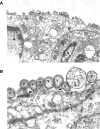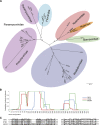Whole genome analysis of sierra nevada virus, a novel mononegavirus in the family nyamiviridae
- PMID: 24778199
- PMCID: PMC4080556
- DOI: 10.4269/ajtmh.14-0076
Whole genome analysis of sierra nevada virus, a novel mononegavirus in the family nyamiviridae
Abstract
A novel mononegavirus was isolated in 1975 from ticks (Ornithodoros coriaceus) collected during investigation of an outbreak of epizootic bovine abortion (EBA) in northern California. It was originally designated "bovine abortion-tick virus" (BA-T virus). The EBA is now known to be associated with a deltaproteobacterium infection, and not a virus. The BA-T virus had remained uncharacterized until now. We have determined by electron microscopy, serology, and genome sequencing that the BA-T virus is a fourth member of the newly proposed family Nyamiviridae, and we have renamed it Sierra Nevada virus (SNVV). Although antigenically distinct, phylogenetically SNVV is basal to Nyamanini virus (NYMV) and Midway virus (MIDWV), two other tick-borne agents. Although NYMV was found to infect land birds, and MIDWV seabirds, it is presently unknown whether SNVV naturally infects birds or mammals.
© The American Society of Tropical Medicine and Hygiene.
Conflict of interest statement
Disclosure: The GenBank accession no. for the Sierra Nevada virus is KF530058. Animal use reported in this work was done under protocol no. 9505045, approved by the IACUC at the University of Texas Medical Branch.
Figures




References
-
- Pringle CR, Alexander DJ, Billeter MA, Collins PL, Kingsbury DW, Lipkind MA, Nagai Y, Orvell C, Rima B, Rott R, ter Meulen V. The order Mononegavirales. Arch Virol. 1991;117:137–140. - PubMed
-
- McKercher DG, Wada EM, Straub OC. Distribution and persistence of infectious bovine rhinotracheitis virus in experimentally infected cattle. Am J Vet Res. 1963;24:510–514. - PubMed
-
- McKercher DG, Wada EM, Ault SK, Theis JH. Viral agents recovered from Ornithodoros coriaceus, a vector of epizootic bovine abortion. Am J Vet Res. 1980;41:803–805. - PubMed
Publication types
MeSH terms
Grants and funding
LinkOut - more resources
Full Text Sources
Other Literature Sources

